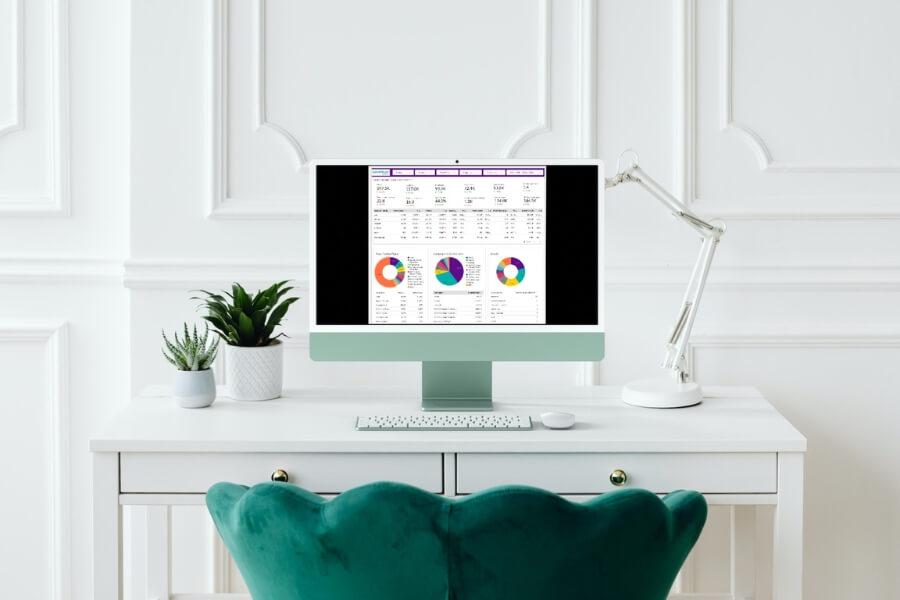Sometimes the idea of advertising online can make business owners break into a little sweat. Business owners tell me time and time again, I tried advertising and it didn’t work or I have tried to make my Google Ads work and I don’t know what is even happening. There is a lot of confusion, overwhelm and often that bad taste feeling you get when you feel that you’ve put more good money after bad. It’s no wonder many businesses are reluctant to get back into advertising online. But the truth is, it is often the fastest way to grow, with trackable metrics and not a single silly dance in sight.
So, if you have advertising in the past or are doing it right now, do you know what your ROAS actually is?
As a number nerd it always gives me great pleasure to see direct results of ad spend.
So ROAS or Return on AD Spend is a great little number to pay attention to – however you do need to be across the inputs for ads and also be able to specifically track purchases/sales.
So YAY ecommerce businesses, not so YAY for service based businesses. Yes can track results, but it’s not as clear cut as you might think.
Essentially it’s knowing for each $1 you spend how many $$$ do you generate.
You can see this inside all of the platforms where you have correctly set up tracking, Google Ads probably does this the easiest – but for any platform, it’s important that you can see the efforts from your ad spend. It’s also important that you include over time that other expenses that might go into this – ie fees to edit your site, fees for ad management etc. This gives the whole picture.
What’s a good ROAS result?
Like most things in ad land and social media land, the answer is ‘depends’
Taken with no context whatsoever, Google Ads says that businesses who spend a dollar, make 2. So would this be good for you? It could very will be yes. Often we aren’t really across our numbers when you factor in your entire business and what your profit actually is. We don’t look at all the inputs, our revenue and then that all important sliver – ie PROFIT.
So it might surprise you to realise that the profit margin for most small businesses in Australia last year was around 15%. But if varies industry to industry, considerably.
So if you think about what you have put into your business ( time and money) to calculate your Return on Investment (ie ROI) and what that percentage is, you might think again about spending on online advertising, when you can get a Return on your adspend of say over 400%.
That’s right – for every dollar your spend, you could generate 4 times that in sales. Many businesses generate a much higher ROAS than 400% consistently.
Why do people hesitate about spending money on ads online?
In my experience, people say things like, I tried ads and it didn’t work.
Which is a fair comment – often they don’t, but the reasons for this are myriad.
Let’s just look at Facebook Ads for a second.
Often people boost a post ( say $50 ) and then say, nothing happened.
Well without diving into their account, I can’t tell exactly why ‘nothing happened’ but I am pretty confident this is what didn’t happen.
- They didn’t choose the right objective when they started the process. Boosted posts, tend to just be about engagement. So where the page owner might have been looking for web traffic/bookings or sales – the cue to FB was actually engagement (likes, comments, shares). Maybe this happened. But in this instance, the page owner wanted a different outcome, but they didn’t actually tell Facebook to do that. Understanding the objective you are looking for inside FB/Instagram is critical.
- Any actual activities were not likely to be tracked correctly. I see this all too often sadly. Enthusiastic page owners start advertising inside FB without ensuring that they have any tracking set up – they usually are missing the FB pixel, so you can’t tell what actual post/event/ad was the real traffic driver.
- No understanding of the reach that your $50 ad spend will generate. The days of cheap FB advertising are long gone. What FB has today though is a reasonable indication of how many people your ad may get in front of, for the money you are prepared to spend each day/for the period. It’s why using AD Manager is so useful – you get an indication of how many people will have your post in their feed, plus some handy indicators of who might take action.
- Are you sending people to the right place? Often sales fail, because where people land is not a converting page – make sure you experience for yourself what your landing pages look like on mobile phones. Also, be critical of the text on the page, does it convert? Is it enticing? Are they expecting that content from your ad?
- Spend is too small to be noticed. ‘nuf said!
Now let’s jump over to Google Ads
Are your Google Ads performing? How would you know?
A key part of any ad campaign, as you would have gleaned from the above is tracking. Are you correctly set up to track what is actually happening as a result of your ads? If you did this yourself, you will discover that there are a few steps involved here to make sure things are correctly in place. It’s why we don’t recommend DIY’ing your Google Ads (unless you have done some training).
Sometimes it can be tricky to correctly allocate revenue from ad campaigns when it’s not a straightforward purchase from a website store. But it can be done – we have a great example of this for a travel company we work with, where we needed to correctly attribute booking revenue from our ads into their 3rd party system. After a few back and forth with software developers, we managed to correctly track all bookings inside Google Analytics and also inside Google Ads. The result – a nice +3000% ROAS for their ad spend.
But another key component of any ad campaign is setting the expectations from the beginning. If you are using Responsive Search ads – what keywords are actually being searched? How much are people spending per click on average? Google helpfully lets you see this as part of doing your keyword research, but many small business owners don’t actually look at this, so again, budgets can be way off and expectations often don’t match the reality. There is no point targeting words that no-one actually uses inside Google, plus you also need to be mindful of the cost you are prepared to pay when doing your ads. What is an ad conversion worth to you?
and this is where we get back to ROAS and why people are sometimes reluctant to spend money online via ads.
Making Smarter Marketing Decisions with Data
We often spend so much time mucking around on social media, we can loose sight of what we are doing in each part of our digital ecosystems. If Social Media is actually driving your sales, then of course analyse why and lean into that.
But, if social media doesn’t actually drive sales ( but you realise the importance of branding and communication that comes from organic social media ) what can you do to actually drive sales more efficiently? How can you determine what marketing activities are driving revenue for your business?
Analyse where your actual sales are coming from.
- Search? If organic search is working and you want more $$$ from here – then Google Ads are a smart choice here, because you know that people are already searching inside Google for your products and services. Taking advantage of Google Ads can really help ramp that up.
- Email? If you sell from email and want more sales, think about how to grow that list. Targeted ads inside Social Media are a great, cost effective( not necessarily cheap) method of building a list that brings long term value to your business month after month. It’s one of my favourites! Do you have a lead magnet in place to entice people to get on your list?
- Referrals? Are people referring you? What websites send traffic your way? Do you even know who these magical sites/people are?
- Social? Is social actually generating sales? If so – why aren’t you advertising inside that platform to leverage that organic footprint further?
How do you know if your business is a candidate for online ads?
Whilst any business is a candidate for online sales, there are a few factors you need to consider. A prime question to ask yourself is, “is my website converting organically” . This is really fundamental (and I am going to come back to this point in a later post) . Are you getting people to complete your forms, buy your products or book appointments online organically. This is usually a good sign that your website is converting all by itself with a combination of clear instructions, good copy and a good offer. No amount of money is really going to fix a poor offer or product. So if the answer is YES to that question, then you can move onto the next question. Where should I be advertising? What platform should I choose for what purpose?
What platform will work best for what stage of the funnel?
If you have an ecommerce business that is selling regularly online and what you to really grow this, then you should be considering Performance Max or Shopping Ads inside Google. People in the mood to buy, generally buy from a search inside Google or go direct to a brand’s website. If your service based business is already getting people to submit your forms, request your list building downloads or booking appointments, then you too can say you are converting online. The question for you as to where you might want to advertise, might be a little more complex. Should you advertise in social media, or via search? Generally speaking, people will respond to top of funnel requests inside social media, but potentially only those looking to commit will do so via a Google Search. So you need to understand your offer before diving into advertising.
Either way, if you know you want to grow and you can see actions happening on your website, the best way to ramp this up is going to be via successful online ads.
Time to take the next step
Stop thinking that spending money on advertising is not going to work for you. It is – you just need to set it up correctly. Then you need to analyse what is actually happening when you start to see your ads convert.
- What is that discovery call actually worth?
- What do you need to do with your online store to lift your average transaction spend to make your ROAS hum?
- What would you do if you knew that for every dollar you spent on advertising you would generate $4 or more – would you do it?
- Would you scale?
I would.
Let me know if you would like to explore this further, as advertising online could be perfect for your business, especially if you want to generate more in a hurry!



